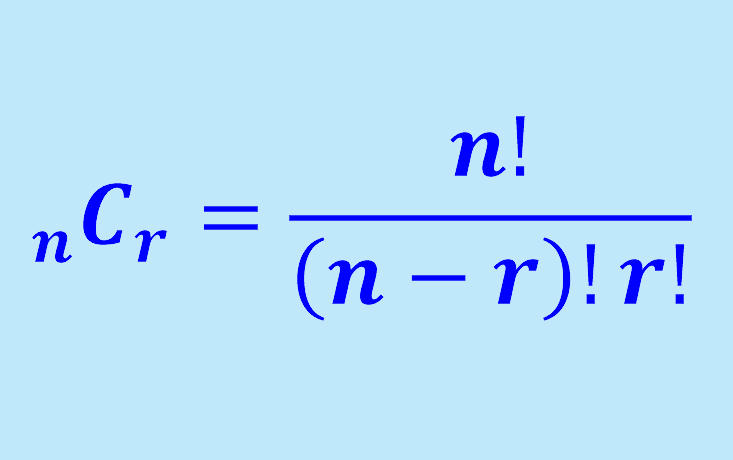Combinations are used to count the number of different ways that certain groups can be chosen from a set if the order of the objects does not matter. This is different from permutations, where the order of the objects does matter.
Here, we will look at a brief summary of combinations along with their formula and the terminology used. In addition, we will see examples with answers to learn about the application of the combination formula.
Summary of combinations
Combinations are selections of objects in a collection, in which the order of the selection does not matter. In combinations, we can select the objects in any order. For example, if we have ab and ba, these selections are considered equal in combinations.
The formula to determine the number of possible organizations by selecting a few objects from a set without repetitions is expressed in the following way:
| $latex _{n}{{C}_{k}}=\frac{{n!}}{{\left( {n-k} \right)!k!}}$ |
where:
- n is the total number of elements in a set
- k is the number of selected objects
- ! is the factorial symbol
Recall that the factorial (denoted as “!”) is a product of all positive integers less than or equal to the number preceding the factorial. For example, $latex 3!=1 \times 2 \times 3 = 6$.
Combinations – Examples with answers
With the following examples, you can practice applying the combination formula. Each exercise has its respective solution to analyze the reasoning behind each answer.
EXAMPLE 1
Find the result of the combination $latex _{8}C_{6}$.
Solution
We use the formula of combinations $latex _{n}{{C}_{k}}=\frac{{n!}}{{\left( {n-k} \right)!k!}}$ and substitute $latex n=8$ and $latex k=6$:
$latex _{8}{{C}_{6}}=\frac{{8!}}{{\left( {8-6} \right)!6!}}$
$latex =\frac{{8!}}{{\left( {2} \right)!6!}}$
Now, we recognize that we can write to 8! like $latex 8 \times 7 \times 6!$ and we eliminate 6! both in the numerator and in the denominator:
$latex \frac{{8!}}{{\left( {2} \right)!6!}}=\frac{{8\times 7}}{2}$
$latex =4\times 7=28$
EXAMPLE 2
Find the result of the combination $latex _{9}C_{4}$.
Solution
We substitute $latex n=9$ and $latex k=4$ in the formula $latex _{n}{{C}_{k}}=\frac{{n!}}{{\left( {n-k} \right)!k!}}$:
$latex _{9}{{C}_{4}}=\frac{{9!}}{{\left( {9-4} \right)!4!}}$
$latex =\frac{{9!}}{{\left( {5} \right)!4!}}$
Now, we recognize that we can write to 9! like $latex 9\times 8\times 7\times 6\times 5!$ and we eliminate 5! both in the numerator and in the denominator:
$latex \frac{{9!}}{{\left( {5} \right)!4!}}=\frac{{9\times 8\times 7\times 6}}{4!}$
We rewrite 4! like $latex 4\times 3\times 2\times 1$ and simplify:
$latex \frac{{9\times 8\times 7\times 6}}{4\times 3\times 2\times 1}=126$
EXAMPLE 3
Find the combination $latex _{100}C_{100}$.
Solution
We substitute $latex n=100$ and $latex k=100$ in the formula $latex _{n}{{C}_{k}}=\frac{{n!}}{{\left( {n-k} \right)!k!}}$:
$latex _{100}{{C}_{100}}=\frac{{100!}}{{\left( {100-100} \right)!100!}}$
$latex =\frac{{100!}}{{\left( {1} \right)!100!}}$
We can easily eliminate 100! both denominator and numerator:
$latex \frac{{100!}}{{\left( {1} \right)!100!}}=1$
This result makes sense since there is only one possible way to select 100 objects from a set of 100 objects if the order does not matter.
EXAMPLE 4
How many ways are there to choose a team of 3 from a group of 10?
Solution
In this case, we choose 3 people so we have $latex k=3$. The whole group is $latex n=10$. Using this data in the formula $latex _{n}{{C}_{k}}=\frac{{n!}}{{\left( {n-k} \right)!k!}}$, we have:
$latex _{10}{{C}_{3}}=\frac{{10!}}{{\left( {10-3} \right)!3!}}$
$latex =\frac{{10!}}{{\left( {7} \right)!3!}}$
We can expand the 10! until you get 7! and we simplify this:
$latex \frac{10!}{(3)!3!}=\frac{10\times 9 \times 8 \times 7!}{(7)!3!}$
$latex =\frac{{10\times 9 \times 8}}{{3!}}$
$latex =\frac{{10\times 9 \times 8}}{{6}}$
$latex =120$
EXAMPLE 5
Suppose we have to select 5 new employees from a list of 10 applicants. In how many ways can this be done?
Solution
In this case, we have $latex n=10$ and $latex k=5$, therefore, we have:
$latex _{10}{{C}_{5}}=\frac{{10!}}{{\left( {10-5} \right)!5!}}$
$latex =\frac{{10!}}{{\left( {5} \right)!5!}}$
We can rewrite 10! until we get 5! and simplify:
$latex \frac{{10!}}{{\left( {5} \right)!5!}}=\frac{{10 \times 9\times 8 \times 7 \times 6 \times 5!}}{{\left( {5} \right)!5!}}$
$latex =\frac{{10 \times 9\times 8 \times 7 \times 6}}{{5!}}$
$latex =\frac{10 \times 9\times 8 \times 7 \times 6}{5 \times 4\times 3 \times 2 \times 1}$
$latex =252$
EXAMPLE 6
In a car dealership, there are 3 cars of a particular model that have to be transported to another dealership. If there are a total of 25 cars of this model, how many options are available to transport?
Solution
We recognize that we have $latex n=25$ y $latex k=3$ and we substitute these values in the formula $latex _{n}{{C}_{k}}=\frac{{n!}}{{\left( {n-k} \right)!k!}}$:
$latex _{25}{{C}_{3}}=\frac{{25!}}{{\left( {25-3} \right)!3!}}$
$latex =\frac{{25!}}{{\left( {22} \right)!3!}}$
We rewrite the factorial 25! until we get to 22!:
$latex \frac{{25!}}{{\left( {22} \right)!3!}}=\frac{{25 \times 24 \times 23 \times 22!}}{{\left( {22} \right)!3!}}$
Now, we simplify to 22! in the numerator and denominator:
$latex \frac{{25 \times 24 \times 23 \times 22!}}{{\left( {22} \right)!3!}}=\frac{{25 \times 24 \times 23}}{{3!}}$
$latex =25 \times 4 \times 23=2300$
EXAMPLE 7
Suppose we have an office of 5 women and 6 men and we have to select a committee of 4 people. In how many ways can we select 2 men and 2 women?
Solution
In this case, we have to find two different combinations and then multiply them. Therefore, we want to calculate $latex (_{5}{{C}_{2}})(_{6}{{C}_{2}})$. We can calculate these combinations separately:
$latex _{5}{{C}_{2}}=\frac{{5!}}{{\left( {5-2} \right)!2!}}$
$latex =\frac{{5!}}{{\left( {3} \right)!2!}}$
$latex =\frac{{5\times 4\times 3!}}{{\left( {3} \right)!2!}}$
$latex =\frac{{5\times 4}}{{2!}}=10$
$latex _{6}{{C}_{2}}=\frac{{6!}}{{\left( {6-2} \right)!2!}}$
$latex =\frac{{6!}}{{\left( {4} \right)!2!}}$
$latex =\frac{{6\times 5\times 4!}}{{\left( {4} \right)!2!}}$
$latex =\frac{{6\times 5}}{{2!}}=15$
Therefore, we have $latex (_{5}{{C}_{2}})(_{6}{{C}_{2}})=10\times 15=150$.
→ Combinations Calculator (nCr)
Combinations – Practice problems
Put your knowledge of combinations into practice with the following problems. Solve the combinations and select an answer. Please check it to make sure you selected the correct one.
See also
Interested in learning more about factorials, permutations, and combinations? Take a look at these pages:




